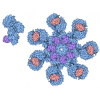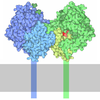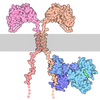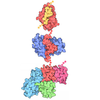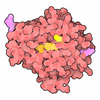+ Open data
Open data
- Basic information
Basic information
| Entry | Database: PDB / ID: 8zui | ||||||||||||||||||||||||
|---|---|---|---|---|---|---|---|---|---|---|---|---|---|---|---|---|---|---|---|---|---|---|---|---|---|
| Title | Binary cluster of TNF-TNFR1 ectodomain complex | ||||||||||||||||||||||||
 Components Components |
| ||||||||||||||||||||||||
 Keywords Keywords | IMMUNE SYSTEM / TNF receptor / Receptor / Receptor cluster | ||||||||||||||||||||||||
| Function / homology |  Function and homology information Function and homology informationpositive regulation of amide metabolic process / tumor necrosis factor receptor superfamily complex / pulmonary valve development / negative regulation of L-glutamate import across plasma membrane / negative regulation of branching involved in lung morphogenesis / negative regulation of bile acid secretion / response to Gram-negative bacterium / positive regulation of interleukin-33 production / positive regulation of neutrophil activation / positive regulation of blood microparticle formation ...positive regulation of amide metabolic process / tumor necrosis factor receptor superfamily complex / pulmonary valve development / negative regulation of L-glutamate import across plasma membrane / negative regulation of branching involved in lung morphogenesis / negative regulation of bile acid secretion / response to Gram-negative bacterium / positive regulation of interleukin-33 production / positive regulation of neutrophil activation / positive regulation of blood microparticle formation / positive regulation of chronic inflammatory response to antigenic stimulus / positive regulation of fractalkine production / aortic valve development / tumor necrosis factor receptor activity / positive regulation of lipid metabolic process / positive regulation of leukocyte adhesion to arterial endothelial cell / negative regulation of extracellular matrix constituent secretion / positive regulation of vitamin D biosynthetic process / positive regulation of protein transport / positive regulation of translational initiation by iron / response to macrophage colony-stimulating factor / positive regulation of apoptotic process involved in morphogenesis / regulation of membrane lipid metabolic process / regulation of endothelial cell apoptotic process / chronic inflammatory response to antigenic stimulus / regulation of branching involved in salivary gland morphogenesis / negative regulation of protein-containing complex disassembly / response to 3,3',5-triiodo-L-thyronine / response to gold nanoparticle / positive regulation of humoral immune response mediated by circulating immunoglobulin / positive regulation of hair follicle development / negative regulation of myelination / response to isolation stress / TNFs bind their physiological receptors / negative regulation of cytokine production involved in immune response / negative regulation of vascular wound healing / tumor necrosis factor binding / negative regulation of amyloid-beta clearance / negative regulation of cardiac muscle hypertrophy / inflammatory response to wounding / positive regulation of interleukin-18 production / death receptor agonist activity / positive regulation of action potential / TNF signaling / epithelial cell proliferation involved in salivary gland morphogenesis / embryonic digestive tract development / toll-like receptor 3 signaling pathway / negative regulation of D-glucose import / vascular endothelial growth factor production / leukocyte migration involved in inflammatory response / response to fructose / positive regulation of neuroinflammatory response / positive regulation of synoviocyte proliferation / necroptotic signaling pathway / positive regulation of calcineurin-NFAT signaling cascade / leukocyte tethering or rolling / positive regulation of mononuclear cell migration / positive regulation of fever generation / negative regulation of myoblast differentiation / positive regulation of protein-containing complex disassembly / regulation of establishment of endothelial barrier / endothelial cell apoptotic process / negative regulation of oxidative phosphorylation / cellular response to toxic substance / positive regulation of protein localization to cell surface / regulation of tumor necrosis factor-mediated signaling pathway / positive regulation of osteoclast differentiation / macrophage activation involved in immune response / negative regulation of systemic arterial blood pressure / tumor necrosis factor receptor binding / positive regulation of heterotypic cell-cell adhesion / positive regulation of cytokine production involved in inflammatory response / positive regulation of macrophage derived foam cell differentiation / regulation of immunoglobulin production / TNFR1-mediated ceramide production / positive regulation of hepatocyte proliferation / positive regulation of programmed cell death / positive regulation of membrane protein ectodomain proteolysis / positive regulation of chemokine (C-X-C motif) ligand 2 production / positive regulation of podosome assembly / positive regulation of extrinsic apoptotic signaling pathway / regulation of canonical NF-kappaB signal transduction / regulation of fat cell differentiation / positive regulation of leukocyte adhesion to vascular endothelial cell / TNFR1-induced proapoptotic signaling / regulation of metabolic process / negative regulation of bicellular tight junction assembly / regulation of reactive oxygen species metabolic process / positive regulation of DNA biosynthetic process / prostaglandin metabolic process / response to L-glutamate / positive regulation of amyloid-beta formation / negative regulation of heart rate / negative regulation of viral genome replication / regulation of synapse organization / negative regulation of fat cell differentiation / negative regulation of endothelial cell proliferation / Interleukin-10 signaling / positive regulation of JUN kinase activity / negative regulation of interleukin-6 production Similarity search - Function | ||||||||||||||||||||||||
| Biological species |  Homo sapiens (human) Homo sapiens (human) | ||||||||||||||||||||||||
| Method | ELECTRON MICROSCOPY / single particle reconstruction / cryo EM / Resolution: 2.56 Å | ||||||||||||||||||||||||
 Authors Authors | Lim, C.S. / Lee, J.O. | ||||||||||||||||||||||||
| Funding support |  Korea, Republic Of, 1items Korea, Republic Of, 1items
| ||||||||||||||||||||||||
 Citation Citation |  Journal: Nat Commun / Year: 2025 Journal: Nat Commun / Year: 2025Title: Highly ordered clustering of TNFα and BAFF ligand-receptor-intracellular adaptor complexes on a lipid membrane. Authors: Chan Seok Lim / Jisun Lee / Ji Won Kim / Jie-Oh Lee /  Abstract: The TNF family plays a critical role in immune regulation. Here, we present high-resolution structures of clusters formed by two TNF receptor family proteins, TNFR1 and BAFFR. Using a lipid monolayer ...The TNF family plays a critical role in immune regulation. Here, we present high-resolution structures of clusters formed by two TNF receptor family proteins, TNFR1 and BAFFR. Using a lipid monolayer method to mimic their membrane-bound state, we observe that the TNFα-TNFR1 complex forms highly ordered clusters of trimers on the lipid membrane. A non-competitive TNFR1 antagonist that inhibits receptor activation disrupted these clusters without blocking ligand binding or receptor trimerization. Furthermore, we find that the BAFF-BAFFR, BAFF-TACI, and BAFF-BCMA receptor-ligand complexes predominantly form pentagonal clusters of trimers on the lipid membrane. Notably, the binding of the intracellular adaptor TRAF3 to the BAFF-BAFFR complex induces a structural transition from a pentagonal to a flat hexagonal cluster. Mutations in BAFF that impair BAFFR activation prevented cluster formation. Our findings demonstrate that ligand binding induces the formation of highly ordered clusters of TNFR1 and BAFFR receptors on the lipid membrane, which is essential for their activation. | ||||||||||||||||||||||||
| History |
|
- Structure visualization
Structure visualization
| Structure viewer | Molecule:  Molmil Molmil Jmol/JSmol Jmol/JSmol |
|---|
- Downloads & links
Downloads & links
- Download
Download
| PDBx/mmCIF format |  8zui.cif.gz 8zui.cif.gz | 353.8 KB | Display |  PDBx/mmCIF format PDBx/mmCIF format |
|---|---|---|---|---|
| PDB format |  pdb8zui.ent.gz pdb8zui.ent.gz | 272.7 KB | Display |  PDB format PDB format |
| PDBx/mmJSON format |  8zui.json.gz 8zui.json.gz | Tree view |  PDBx/mmJSON format PDBx/mmJSON format | |
| Others |  Other downloads Other downloads |
-Validation report
| Summary document |  8zui_validation.pdf.gz 8zui_validation.pdf.gz | 1 MB | Display |  wwPDB validaton report wwPDB validaton report |
|---|---|---|---|---|
| Full document |  8zui_full_validation.pdf.gz 8zui_full_validation.pdf.gz | 1.1 MB | Display | |
| Data in XML |  8zui_validation.xml.gz 8zui_validation.xml.gz | 62.9 KB | Display | |
| Data in CIF |  8zui_validation.cif.gz 8zui_validation.cif.gz | 89.8 KB | Display | |
| Arichive directory |  https://data.pdbj.org/pub/pdb/validation_reports/zu/8zui https://data.pdbj.org/pub/pdb/validation_reports/zu/8zui ftp://data.pdbj.org/pub/pdb/validation_reports/zu/8zui ftp://data.pdbj.org/pub/pdb/validation_reports/zu/8zui | HTTPS FTP |
-Related structure data
| Related structure data |  60484MC M: map data used to model this data C: citing same article ( |
|---|---|
| Similar structure data | Similarity search - Function & homology  F&H Search F&H Search |
- Links
Links
- Assembly
Assembly
| Deposited unit | 
|
|---|---|
| 1 |
|
- Components
Components
| #1: Protein | Mass: 18855.344 Da / Num. of mol.: 6 Source method: isolated from a genetically manipulated source Details: TNF ligand / Source: (gene. exp.)  Homo sapiens (human) / Gene: TNF, TNFA, TNFSF2 / Production host: Homo sapiens (human) / Gene: TNF, TNFA, TNFSF2 / Production host:  Trichoplusia ni (cabbage looper) / References: UniProt: P01375 Trichoplusia ni (cabbage looper) / References: UniProt: P01375#2: Protein | Mass: 22190.912 Da / Num. of mol.: 6 Source method: isolated from a genetically manipulated source Source: (gene. exp.)  Homo sapiens (human) / Gene: TNFRSF1A, TNFAR, TNFR1 / Production host: Homo sapiens (human) / Gene: TNFRSF1A, TNFAR, TNFR1 / Production host:  Trichoplusia ni (cabbage looper) / References: UniProt: P19438 Trichoplusia ni (cabbage looper) / References: UniProt: P19438Has protein modification | Y | |
|---|
-Experimental details
-Experiment
| Experiment | Method: ELECTRON MICROSCOPY |
|---|---|
| EM experiment | Aggregation state: PARTICLE / 3D reconstruction method: single particle reconstruction |
- Sample preparation
Sample preparation
| Component | Name: Binary cluster of TNF-TNFR1 ectodomain 3:3 complex / Type: COMPLEX / Entity ID: all / Source: RECOMBINANT | |||||||||||||||
|---|---|---|---|---|---|---|---|---|---|---|---|---|---|---|---|---|
| Molecular weight | Experimental value: NO | |||||||||||||||
| Source (natural) | Organism:  Homo sapiens (human) Homo sapiens (human) | |||||||||||||||
| Source (recombinant) | Organism:  Trichoplusia ni (cabbage looper) Trichoplusia ni (cabbage looper) | |||||||||||||||
| Buffer solution | pH: 7.8 | |||||||||||||||
| Buffer component |
| |||||||||||||||
| Specimen | Conc.: 0.1 mg/ml / Embedding applied: NO / Shadowing applied: NO / Staining applied: NO / Vitrification applied: YES | |||||||||||||||
| Specimen support | Grid material: GOLD / Grid mesh size: 300 divisions/in. / Grid type: Quantifoil R1.2/1.3 | |||||||||||||||
| Vitrification | Instrument: FEI VITROBOT MARK IV / Cryogen name: ETHANE / Humidity: 100 % / Chamber temperature: 293 K |
- Electron microscopy imaging
Electron microscopy imaging
| Experimental equipment |  Model: Titan Krios / Image courtesy: FEI Company |
|---|---|
| Microscopy | Model: TFS KRIOS |
| Electron gun | Electron source:  FIELD EMISSION GUN / Accelerating voltage: 300 kV / Illumination mode: FLOOD BEAM FIELD EMISSION GUN / Accelerating voltage: 300 kV / Illumination mode: FLOOD BEAM |
| Electron lens | Mode: BRIGHT FIELD / Nominal defocus max: 2000 nm / Nominal defocus min: 800 nm |
| Image recording | Electron dose: 50 e/Å2 / Film or detector model: GATAN K3 BIOQUANTUM (6k x 4k) |
- Processing
Processing
| CTF correction | Type: PHASE FLIPPING AND AMPLITUDE CORRECTION | |||||||||||||||||||||
|---|---|---|---|---|---|---|---|---|---|---|---|---|---|---|---|---|---|---|---|---|---|---|
| Symmetry | Point symmetry: C2 (2 fold cyclic) | |||||||||||||||||||||
| 3D reconstruction | Resolution: 2.56 Å / Resolution method: FSC 0.143 CUT-OFF / Num. of particles: 1800466 / Symmetry type: POINT | |||||||||||||||||||||
| Atomic model building | Protocol: RIGID BODY FIT | |||||||||||||||||||||
| Atomic model building |
| |||||||||||||||||||||
| Refinement | Cross valid method: NONE |
 Movie
Movie Controller
Controller





 PDBj
PDBj


